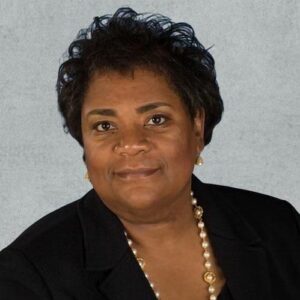
Path to Medicine: The Mission and Vision of the CUNY School of Medicine
About Dean Green
Dr. Carmen Renee Green, Dean of the CUNY School of Medicine (CSOM), is a trailblazer in healthcare equity and is dedicated to addressing systemic disparities and fostering diversity in medicine. Her research in pain management and minority and women’s health, has exposed race-based inequities in healthcare. She has also played a key role in shaping inclusive health policies, with contributions to the National Pain Care Policy Act within the Affordable Care Act, enacted under President Barack Obama.

As Dean, Dr. Green has led CSOM through major milestones, including full LCME accreditation, which ensures the institution meets national standards and allows graduates to pursue medical licensing. Green has also led initiatives like the Bridge to Clerkship program and the Virtual Anatomy program, reinforcing the CSOM mission to increase access to medical education for underrepresented students. Dr. Green continues to drive change in public health through innovative approaches such as narrative medicine and photovoice projects in order to train CSOM students to be compassionate advocates for healthcare equity.
CUNY School of Medicine: A Unique Approach to Medical Education and Healthcare Equity
For decades, the CUNY School of Medicine (CSOM), formerly known as the Sophie Davis School of Biomedical Education, has stood as an incredible vehicle of opportunity for students from underrepresented backgrounds aspiring to become physicians. Located at The City College of New York (CCNY), CSOM has a mission deeply rooted in addressing healthcare disparities, increasing diversity in the medical field, and expanding access to medical education for students from low-income households.
Recently, CSOM has seen significant developments, including plans for institutional independence and increased funding to contribute to its role in training future doctors. In a recent interview with theHIPE, CSOM’s dean, known as “Dr Dean Green” to her students, shed light on the school’s unique structure as a 7-year BS/MD program, its impact on underserved communities, and its future vision as it transitions into an independent entity within the CUNY system.
A Different Kind of Medical School
CSOM is not your typical medical school. It offers an accelerated program that allows for its students to complete their undergraduate and medical education in a combined 7 years, instead of the traditional 8+ years it would take a student to obtain a medical degree. The program accelerates the undergraduate portion of the students education into 3 years, allowing for them to matriculate into CSOM a year earlier than typical pre-med students. This combined with 4 years at CSOM allows them to obtain a MD in 7 years. One of the most unique and special characteristics of this program is that it eliminates the need for students to take the MCAT. Meaning, so long as they meet the GPA requirements for their undergraduate courses, they will be able to matriculate into the medical school (CSOM).
Admission to this program is based on a holistic review of applicants, emphasizing academic excellence, commitment to service, and the potential to address healthcare disparities. Typically, students apply to the program during your senior year of high school. However, it is also possible to transfer into the program within your first year of college. Current transfer students have been from CCNY and other CUNY Colleges, applications are usually due December 31st, with interviews beginning February and can go all the way until mid March.
This combined degree program structure is particularly significant in a country where the cost and length of medical education can be the most significant barriers for many students. According to Dean Green, this program model allows CSOM to identify talent from diverse socioeconomic backgrounds.
Addressing Diversity in Medicine
One of CSOM’s most impressive achievements is its role in increasing the number of Black and Latino doctors in the United States. The statistics are incredible—CSOM is one of the top producers of underrepresented physicians in New York City and the country as a whole. The CSOM trains 1 in 5 black M.D. students in New York City.

This is imperative because Black and Latino physicians are significantly underrepresented in the field of medicine. According to the Association of American Medical Colleges (AAMC), only about 5% of doctors in the U.S. are Black, and 5.8% are Latino despite these groups making up a much larger percentage of the population. Research consistently shows that patients receive better care when treated by doctors who understand their backgrounds and lived experiences, making institutions like CSOM essential in bridging gaps in healthcare quality and access.
Green emphasized that increasing representation in medicine is not just about equity—it’s also about improving patient outcomes.
The Push for Independence
One of the most significant upcoming changes for CSOM is its transition into an independent medical school within CUNY. This move will grant the institution greater flexibility in expanding its programs, increasing faculty, and securing resources for students. “Becoming an independent institution will allow us to control our curriculum and growth in ways we couldn’t before,” the dean explained. “This means more opportunities for students, better funding, and a stronger pipeline of physicians for New York’s most underserved communities.”
Currently, CSOM remains relatively small compared to other medical schools, which the dean sees as both a challenge and an opportunity. “Other medical schools are like ships, we are like a speedboat.” The close-knit environment allows for personalized support and active improvement, but independence will enable the school to grow while maintaining its mission.
Expanding Health Equity Research
Beyond training future doctors, CSOM is also deepening its commitment to health equity research. Recently, the school secured a $19.3 million grant from the National Institutes of Health (NIH) to establish a Health Equity Center. This center will focus on studying and addressing healthcare disparities, particularly in Harlem and the South Bronx, two areas that have long suffered from inadequate medical resources.
the dean said. “This funding allows us to tackle issues like chronic disease disparities, access to preventive care, and systemic biases in medical treatment.” The center will also provide opportunities for students to engage in research early in their medical careers, ensuring that they graduate not only as clinicians but as advocates for systemic change throughout their careers and lives.
Investing in the Future
CSOM’s vision for the future is quite ambitious. In addition to becoming an independent institution and expanding research initiatives, the school is focusing on increasing faculty diversity by bringing in “new faces” and strengthening partnerships with hospitals.
One challenge many medical students face is the financial burden of medical education. While CSOM’s program is designed to be more affordable than traditional routes, a NY state resident full-time student tuition for medical school costs $20,800 per semester and a non-resident full-time student $34,630 per semester. This would mean that NY resident students’ medical education would cost them $166,400 and $277,040 for non-residents. According to the Princeton Reviewa>, “the median four-year cost of public medical schools is $268,476 for resident students, while students at private medical schools pay a median of $363,836.” This makes CSOM’s program significantly more affordable, aligning with its mission to provide accessible medical education to minority and low-income students who deserve to have opportunities at pursuing a career in medicine without the burden of high tuition fees standing in the way.
The Broader Impact
The success of CSOM in increasing the diversity of physicians highlights a larger issue in the U.S. medical education system: the need for more institutions that focus on accessibility, diversity, and community engagement. “Our students don’t just leave with medical degrees; they leave with a mission,” the dean stated. “They are trained to see themselves not just as doctors, but as change agents in healthcare.”
As the school moves toward independence and expands its initiatives, its impact will only grow. By continuing to break down barriers to medical education and placing health equity at the core of its mission, CSOM is shaping the future of healthcare in New York City and beyond.
.jpeg)
About the Author
Shakhrizoda is an editor for the HIPE Ezine, where she creates engaging and informative content about pathways to medicine. Her work aims to broaden awareness and inspire students across CUNY to explore careers in healthcare.


